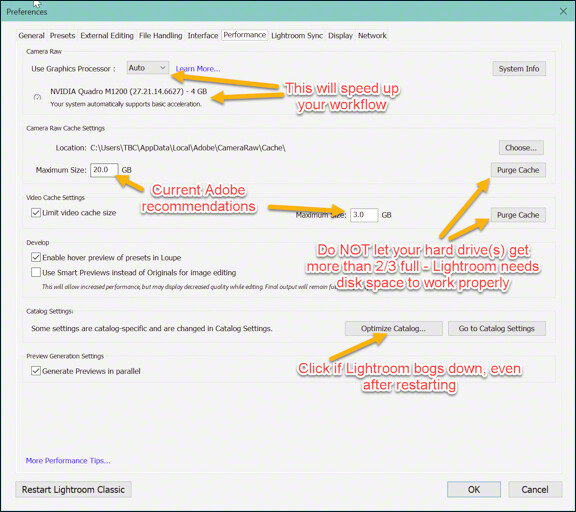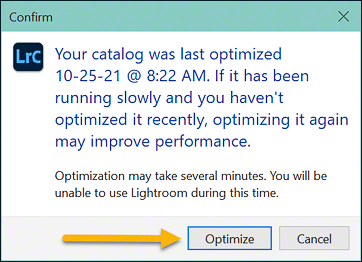Originally published December 2013 and most recently updated October 27, 2021.
 The Care and Feeding of Your Lightroom Catalog could just as easily be called The Health and Maintenance of Your Lightroom Catalog. But catalogs are not static, and I preferred the title above.
The Care and Feeding of Your Lightroom Catalog could just as easily be called The Health and Maintenance of Your Lightroom Catalog. But catalogs are not static, and I preferred the title above.
So, why the cactus images? Lightroom can get what I call nudgy. It gets prickly and uncooperative. You do a normal task and get the most fascinating results, usually not at all what you had in mind.
In my blog called Lightroom Setup, which I have recently updated, I made some suggestions for setting up your preferences in Lightoom. I would start there.
I have already made some revisions to this blog based on input from both our readers and Lightroom expert Rob Sylvan, formerly of the help desk at what was then called NAPP, as well as his own Lightroomers.
This time, we’ll address what I call the care and feeding of your Lightroom catalog to keep it healthy.

Computers fail. Programs fail. So, it is not a question of if something will fail, rather when it will.
Most of us have been through it to one degree or another. The information gets lost in the worst sand storm in recent decades, and it’s a long, dusty road getting everything back to the way we want it.
Backing up your information is critical to the health and survival of anyone owning a computer. For those who want to read more on this, go to my blog Backup, Backup, Backup.
A couple of reminders. Some people have computers with minimal capabilities for the latest versions of Lightroom (we are now several iterations into what now is called Lightroom Classic 10.4). While we recommend choosing in your Catalog Settings to “Backup once a day when exiting Lightroom,” you may Skip this operation sometimes when exiting Lightroom when you do not have time, but don’t forget to backup the next time!. Those people with borderline computer capabilities may wish to Optimize in a separate action from Backing up. While we have not experienced this, some people have reported Lightroom crashing when trying to Optimize in the same operation as Backing up.
There are several other things you can adopt to keep your Lightroom catalog working well.
First, for those who don’t know, something to remember is that Lightroom can almost be thought of as a browser with the capability of adding instructions to your image file as to how it should be processed. Your images are not “in” Lightroom; rather Lightroom can view thumbnails of your images and allow you to work on them.
More properly, that work is actually creating a set of instructions for your images so that the next time they are developed, the instructions you have given will show up on the exported images in addition to the thumbnails you view on your computer screen. Just because you are not online at www.BCphotoadventures.com, for example, does not mean it doesn’t still exist. It’s there waiting for you the next time you access it through Chrome, Firefox, Safari, Internet Explorer, etc. Similarly, even if your Lightroom catalog fails, your images are still exactly where you put them.
Yup, you tell Lightroom where you want those images filed. It goes back to the concept that you bought the computer and program. They did not buy you!
Because we are dealing with RAW files, we are not changing the files themselves, only the instructions for them such as your copyright information, Margo’s Tweaks (our alumni know what these are), burning here, adding a tad of saturation deepening the shadows and blacks there, converting it into a black-and-white photo, adding or subtracting some luminence and clarity, etc.
As long as Lightroom is working, those instructions will be there for each image when you next open up the program. But if something goes awry? Unless you have saved your instructions — the work you have done on the image — to the image file itself, all could be lost. What to do?
Easy. Every time I import images onto my hard drive, simultaneously applying my copyright information and Margo’s Tweaks, I select All my images (on Macs, CMD-A, and on PCs, CTRL-A), and Save them all (CTRL-S / CMD-S). Then I Deselect them all (CMD-D / CTRL-D).
Remember, do NOT do that CMD-D or CTRL-D in any other program. You may delete things that you wish to keep!!!
At the very least, all my copyright metadata and preliminary tweaks are saved with the image files themselves.
After that, every time I work on an image, I do a CTRL-S / CMD-S. That way, even though the history steps may be lost in a Lightroom or computer meltdown, the end results, as represented by all those pins and lines and circles, are still there, with my instructions, and the next I access the image, and I can go back and tweak those adjustments more and/or add new ones.
 Now, let’s go to some practices that will reduce the chance of Lightroom going south. In the Performance tab in Preferences (Lightroom > Preferences in Mac, Edit > Preferences on PCs) that we addressed in the Lightroom Setup blog, you will notice over on the right of the Camera Raw Cache Setting section, a nice button that is labeled Purge Cache! Make sure you don’t select the Video one, unless, of course, you also do a lot of videos.
Now, let’s go to some practices that will reduce the chance of Lightroom going south. In the Performance tab in Preferences (Lightroom > Preferences in Mac, Edit > Preferences on PCs) that we addressed in the Lightroom Setup blog, you will notice over on the right of the Camera Raw Cache Setting section, a nice button that is labeled Purge Cache! Make sure you don’t select the Video one, unless, of course, you also do a lot of videos.
I make a habit of purging my cache often. At least once a week if I have been doing a lot of work on my images, perhaps only once a month if I have not. Both Lightroom and its mega sibling, Photoshop, are incredible memory hogs. Anything we can do to alleviate the tax on the memory is to our benefit. Purging the cache, by the way, just empties out your previews. Don’t worry, Lightroom will make you new ones the next time you work on an image, and you will not lose any of the work you have done on any images. Sometimes, we go to a 1:1 preview to work on a small area of an image (removing dust motes on the sensor, for example). Those 1:1 previews take up a LOT of room.
 If we have been doing a lot of work in Lightroom, it can get twitchy (very technical term) and recalcitrant (another computer term!), exhibiting somewhat bizarre behavior. What to do here? Also easy. Go to File > Optimize and start the process. I find doing this at least once a month makes everything run more smoothly; and I do it more often if I have been doing a lot of work in Lightroom. It will take a while, so go have a nice glass of wine before dinner, take a walk, or do some chores.
If we have been doing a lot of work in Lightroom, it can get twitchy (very technical term) and recalcitrant (another computer term!), exhibiting somewhat bizarre behavior. What to do here? Also easy. Go to File > Optimize and start the process. I find doing this at least once a month makes everything run more smoothly; and I do it more often if I have been doing a lot of work in Lightroom. It will take a while, so go have a nice glass of wine before dinner, take a walk, or do some chores.
One of our alumni came up with another suggestion that I had forgotten to mention, since I automatically do it routinely. That is, keep purging the older backups. Usually, this folder is in your Lightroom folder, so run a search on your computer to find where you keep yours, either by default or on purpose. Look for a Backup folder within a Lightroom one. These backup files can be humongous, so I only keep the two most recent.
To that, I would urge you to NOT save your backups on the same drive as your catalog, even though Lightroom defaults to that location. Remember, it is never a question of if your computer or hard drive will fail, rather when! If you use an external hard drive for your catalog, for example, back it up onto your computer.
Sometimes, you do everything right, been diligent about the care and feeding of your Lightroom catalog, regularly done your Backup, Backup, Backup, purged your cache regularly, optimized, yet something still happens. Your tools, for example behave in a bizarre manner as happened to me a number of years ago in Death Valley.
We had experienced a sand storm, the likes of which had not been seen for many decades in the valley. The electricity kept blipping on and off, the Internet went Kaput, and life on a computer was challenging at best, not to mention coping with the fine sand that seeped in under the door and window and even clogging the air-conditioning/heating unit filters.
I went to work on an image in Lightroom that was behaving quite nicely, thank you very much, the previous afternoon. Hmmm. The cropping tool worked fine. So did the clone/heal tool. But when I went to use the brush or graduated tool on two of my favorites, things went south.
Arghhh! I could click on the tool just fine. I could even adjust my settings. But when I actually clicked on the image, it went gray. Scary! I could click on another image, and the gray image was restored, but I could not use these two tools on it. Inconvenient, to say the least, especially when I was trying to get out a blog in the limited time I don’t have during a workshop.
Following my own suggestions, I did all the above things, even though I had quite recently purged my cache and optimized my catalog, but I still got the same, inexplicable behavior. Hmmm! I wonder if my catalog will work on Arnie’s computer? Wonder of wonders … perfectly! Inconvenient, but at least it was a temporary work-around.
 Saturday night, a number of years ago, I wrote the help desk at that now-defunct NAPP, knowing I was unlikely to get a response until the following Monday, if then. Much to my delight and surprise, Rob Sylvan, who has been most helpful in the past, had a response waiting for me early Sunday morning. WOW!
Saturday night, a number of years ago, I wrote the help desk at that now-defunct NAPP, knowing I was unlikely to get a response until the following Monday, if then. Much to my delight and surprise, Rob Sylvan, who has been most helpful in the past, had a response waiting for me early Sunday morning. WOW!
After a few knit eyebrows and some rapid back and forth of information and have you tried this, and yes I already did that, Rob came up with the solution. Kudos to Rob once again! And in the process, we discovered we have quite a few connections. Small-world department.
The solution was quite simple, and I will refer you to Rob’s site so he can tell you in his own words. Worked like a charm, and I am happy to say I had not torn out all my hair and gone bald before he was able to come up with the fix. My prickly program is no longer prickly. It is once again working smoothly!
As you read Rob’s piece, understand that we were experiencing major blips on the electronic front. Lightroom was inadvertently shut down numerous times improperly, and thus brought about the circumstances that led to its misbehaving.
Victoria Bampton, The Lightroom Queen, is also very helpful and responsive. There are others, of course, but these are the ones I like as resources.
Another trick if Lightroom just does not want to open is to delete a strange file called Lightroom Catalog.lrcat.lock found in your Lightroom folder along with your regular lrcat keywords and/or collections for gathering groups of similar photographs. Your Catalog may have a different name, but that .lrcat.lock is what you are looking for tacked on to the end. lrcat, by the way stands for LightRoom Catalog!
This is also a reminder that you should always exit Lightroom when putting your computer to sleep or shutting it down completely.
 And when you upgrade to a newer version of Lightroom, allow it to upgrade/update your current catalog. Once you know it is working properly, you may (and should) uninstall the older version of Lightroom. This applies to all major version jumps. The interim steps do not produce an entirely new program, and the next time I have to install a major upgrade, I will include an up-to-date screen shot.
And when you upgrade to a newer version of Lightroom, allow it to upgrade/update your current catalog. Once you know it is working properly, you may (and should) uninstall the older version of Lightroom. This applies to all major version jumps. The interim steps do not produce an entirely new program, and the next time I have to install a major upgrade, I will include an up-to-date screen shot.
So, establish sensible and consistent practices, pay attention to the care and feeding of your Lightroom catalog, and you should have few glitches.
If you enjoy our blog(s) …
Please SUBSCRIBE. It’s easy to do by clicking on the appropriate link at the top of the right column.
Comments on the blog are always encouraged and welcome.
We also hope you will LIKE this and SHARE this blog with those interested in photography by clicking on the buttons below. We also hope you will check out these links: